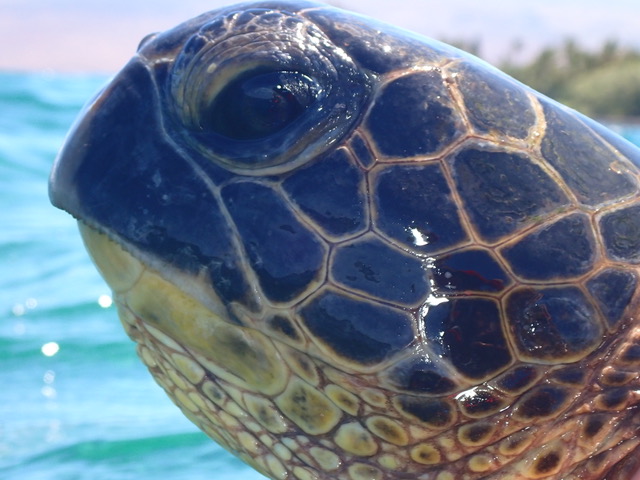TURTLE RESCUE - KAHALU'U STATE PARK
UPDATE: Our Kahalu'u turtle seems to being doing well and the flipper is healing nicely. It has been observed feeding and it is using the flipper to swim (which it wasn't before).
Kathleen Clark (Kohala Center)writes:
Over the last few weeks we have observed the turtle feeding and over the weekend one of our volunteers took a video of it using its injured flipper to swim! The attached photo shows the turtle in mid September before it was assisted and the next one shows its current status.
 |
| K20 injury in mid-September (pre-treatment) |
 |
| K20's current status.. healing nicely..as of Nov. 15, 2020. |
Video of K20 taken by a Kahalu'u Reef Teach Volunteer showing that K20 is able to use its flipper to swim.
The turtle resting under the coral head. You can see the white fringe on the right front flipper. The white material is necrotic tissue and indicates that there is something amiss with the flipper. This is typical of a flipper that has been affected by fishing line entanglement.
Above and below are images of the right front flipper showing the necrosis of the tissue.
It was proposed that we try and recover that animal and see if we could evaluate the injury and decide if the turtle might be able to survive and if we could help it get well.
On Friday, September 25th, Laura Jim and Marc Rice from the Hawaii Preparatory Academy's Sea Turtle Research Program went down to Kahalu'u to try to recover this turtle and allow a veterinarian to evaluate the injury and make a decision on what to do for the honu.
We were able to capture the animal with the help of the reef teach folks and put it into a carrier for transport to the veterinarian in Ocean View. It took us about 1 hour to drive south to ocean view where we had Dr. Agnes Horvath evaluate the health and prognosis of the turtle.
We drew a blood sample, did a packed cell volume and total protein analysis and found both within an acceptable range. External observation showed that the little honu was still robust in its movements and that it had innervation and circulation in the injured flipper. After conferring with a turtle specialist NOAA veterinarian it was decided that the turtle was healthy enough to remain in the wild and allow it time to heal. Dr. Horvath abraided and cleaned the wound and put antiseptic material on the wounded area.
Subsequently, we drove the turtle back to Kahalu'u and released it at 1330 hours on the same day. Laura and Kathleen released the turtle which swam off. It has been observed frequently since the being release and seems to be doing ok so far.
 |
| Kathleen and Laura carry the injured Honu back to Kahalu'u Bay. |
 |
| The little guy swims free and, hopefully, it will be able to heal itself over the next few months. |
We won't know for several months if it is going to survive but at least it has a chance.








































